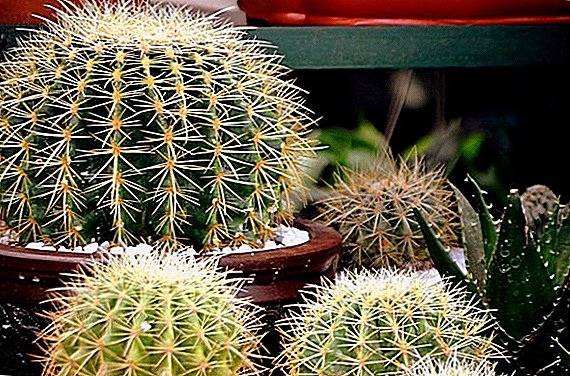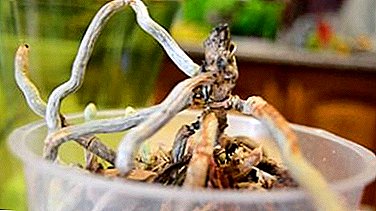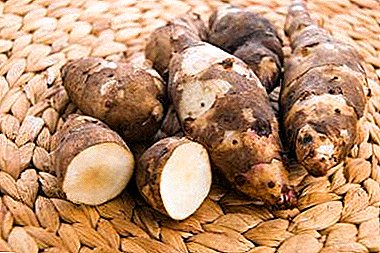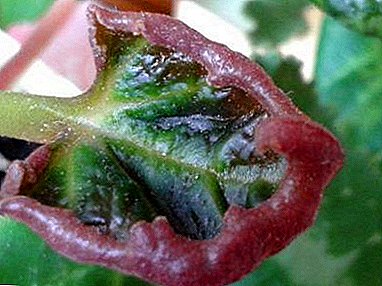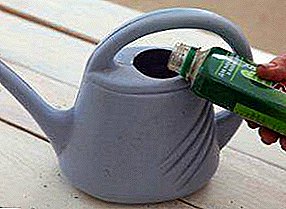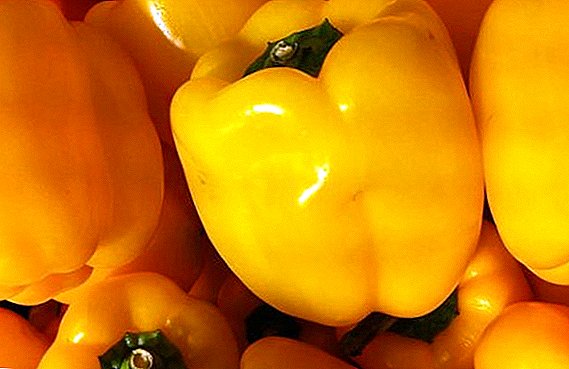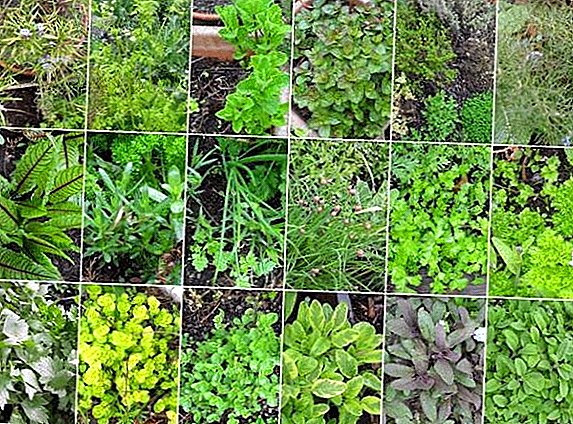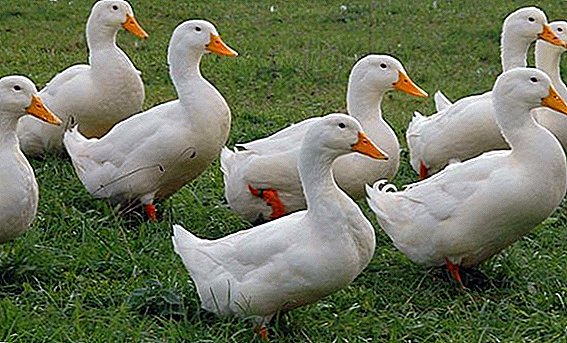 If you are new to the poultry industry and decide to start your experience with duck breeding, “peking” is the best option to start! This is a rather old, proven breed of meat poultry, which is successfully used in breeding for breeding more and more new species. These ducks are bred everywhere both on an industrial scale and in small farms, and have earned good fame thanks to its unpretentiousness, rapid growth and very tasty and balanced meat. Perhaps, taking into account all these qualities, there are practically no worthy competitors for Peking.
If you are new to the poultry industry and decide to start your experience with duck breeding, “peking” is the best option to start! This is a rather old, proven breed of meat poultry, which is successfully used in breeding for breeding more and more new species. These ducks are bred everywhere both on an industrial scale and in small farms, and have earned good fame thanks to its unpretentiousness, rapid growth and very tasty and balanced meat. Perhaps, taking into account all these qualities, there are practically no worthy competitors for Peking.
Breed description
As the name of the breed suggests, its homeland is China. It is the Celestial Empire that is famous for its famous Peking Duck dish.
Did you know? There are several versions of the origin of the term "newspaper duck", which is used to describe the false news published in the media. It must be admitted that not all of them are directly connected with the bird, some are based on the game of consonant words in different languages. But here are two purely "duck" newspaper myths: at the end of the XVIIIth century, one French edition printed an original way of duck hunting, suggesting a special infection of one individual, which would spread the disease to others, and they could be taken with bare hands. Two centuries later, an article appeared in the same country about the unique gluttony of ducks, confirmed allegedly by the fact that one person, having twenty ducks, fed them one after another so that in the end there was one who had eaten all the others.
So, let's start a detailed conversation about the Peking duck with a description of the breed.
History of origin
Officially, it is assumed that the breed was bred about three hundred years ago in the Chinese capital.  However, according to the legend, the Chinese engaged in the domestication of the white duck a thousand years ago, when the emperors of the Jin and Yuan dynasty, hunting these ducks for hunting, managed to appreciate the high quality of the meat of this bird and desired to have this high-quality product in their kitchen.
However, according to the legend, the Chinese engaged in the domestication of the white duck a thousand years ago, when the emperors of the Jin and Yuan dynasty, hunting these ducks for hunting, managed to appreciate the high quality of the meat of this bird and desired to have this high-quality product in their kitchen.
As a result, the Peking ducks were first fed, then their breeding began at home, and finally they got a species that has been successfully grown to this day: not only in China, but all over the world.
In the past at least a hundred years, this bird is unusually popular in the United States of America and practically throughout Europe.  In China itself, in the production of this bird, entire business empires are built: it gives work to a huge number of Chinese, and thus feeds them in every sense of the word.
In China itself, in the production of this bird, entire business empires are built: it gives work to a huge number of Chinese, and thus feeds them in every sense of the word.
Learn about the features of breeding musk ducks, blue favorites, Bashkir, Mulard and Mandarin ducks.
External characteristics
The Peking duck is distinguished by its strong build, wide body, covered with thick white, less often cream plumage, powerful wings adjacent to the body and a large head with a characteristic bulging forehead and a flat orange-colored beak.
Legs short, but strong. A short elegant neck and a coquettishly raised small tail complete the look. The weight of the grown-up female varies within 3.5 kg, sometimes the drakes gain a little more than 4 kg.  Young animals that are rapidly gaining weight with proper care already weigh a little less than 3 kg by the age of two months. - It is at this age that poultry meat is the most succulent, soft, lean and balanced, and it is used to make the famous Peking Duck.
Young animals that are rapidly gaining weight with proper care already weigh a little less than 3 kg by the age of two months. - It is at this age that poultry meat is the most succulent, soft, lean and balanced, and it is used to make the famous Peking Duck.
Did you know? Intelligent Britons respect animals so much that for their sake they are even ready to temporarily stop the war. So it was at the beginning of the last century in Dublin, where the military conflict between the British and the Irish tried to resolve on the territory of the national park. At the time of feeding the ducks living in the park, hostilities ceased, and both sides watched with reverence for the unhurried meal of the birds.
Productivity
Peking ducks are very profitable in terms of growing. Unlike, say, from partridges that create monogamous families, these birds can be acquired from - one drake per five females.  As soon as it reaches the age of six months, the duck begins to nest, and its productive period can last up to three years. How many eggs a Peking duck carries, of course, depends on the conditions of detention: on average, with good care, you can count on a hundred or even a half per year.
As soon as it reaches the age of six months, the duck begins to nest, and its productive period can last up to three years. How many eggs a Peking duck carries, of course, depends on the conditions of detention: on average, with good care, you can count on a hundred or even a half per year.
In the Peking duck, not only meat is valued, but also the eggs themselves. They weigh up to 90 g (this is one and a half to two times more than a chicken egg).
Learn how to build a house with your own hands and equip a room for growing indoutok.Duck eggs - a real delicacy and, moreover, quite a rarity. In eastern countries, for example, in Japan and China, they are even pickled in herbs and spices, thanks to which the product can be stored for several months.
Did you know? The most unusual recipes for duck eggs, perhaps, can boast of Chinese and Filipinos. The first ones add sesame seeds and lime to the product, as a result of which the yolk acquires a greenish tint, but the protein turns black. This culinary delicacy is called "imperial eggs". But the Filipino "balut" - it is generally an egg cooked after a full-fledged chick is already inside it instead of the usual yolk and white.
Thus, the Peking duck has a very high productivity, given the rapid growth, early achievement of puberty and a high number of eggs. But this breed does not end there.
Advantages and disadvantages of the breed
Peking ducks compared to other poultry are very easy to maintain. In addition to numerous arguments “for” the choice of this type, there are some drawbacks. 
pros
The advantages of the breed (taking into account the above) are that the Peking duck:
- adapts well in any climatic conditionsboth intensely warm and extremely cold (otherwise she would not have been able to conquer such a large number of countries and continents);
- quite picky in terms of selection of the diet;
- quickly gaining weight;
- early begin to rush (for this type of waterfowl, the average age at which the female lays the first eggs is 6-8 months, while in Peking this period comes before the lower limit);
- can be divorced far from water (however, the majority of domestic ducks have this ability, however, it should be borne in mind that it is in open water that these waterfowl produce about a tenth of the food, so the presence of a pond nearby will greatly save the breeder);
- has high quality meat relatively low fat content.
Learn all about breeding peacocks, ducks, pheasants, geese, turkeys and broilers.
Minuses
In fact, there is only one lack of a breed. These ducks are not too willing to hatch eggs, and therefore sometimes it is necessary to organize an artificial incubator.  That is why the only competitor in the breed is the egg-bearing duck, which, however, is inferior to the "peking" in all other parameters.
That is why the only competitor in the breed is the egg-bearing duck, which, however, is inferior to the "peking" in all other parameters.
Sometimes poultry farmers also note the high demands that the bird makes on the dryness of the room where it is kept, but this feature can be attributed with confidence to any poultry.
Content Features
As has been said, these birds grow very quickly. But only until the first molt, then weight gain is significantly slowed down (development goes "in feather"), and, figuratively speaking, the duck ceases to pay for itself.
In addition, young meat is valued much higher than the old one, so the "Pekinok" is usually killed at the age of two months.  Of course, all the above mentioned advantages and advantages of the breed can be assessed only if two conditions are met: the first - the acquisition of high-quality breeding material the second - compliance with the optimal conditions of detention, including the room, food and even the creation of an emotional background.
Of course, all the above mentioned advantages and advantages of the breed can be assessed only if two conditions are met: the first - the acquisition of high-quality breeding material the second - compliance with the optimal conditions of detention, including the room, food and even the creation of an emotional background.
Requirements for the room
We begin to prepare the premises for the house from the floor.
Important! Do not install a fence for ducks directly on the ground. The floor must be very carefully insulated and protected from the penetration of rodents who like to climb into closed buildings for the winter.If the floor is concrete, wood should be laid on it. The walls can be brick or timbered, but very well insulated in order to avoid drafts, heat leakage and moisture penetration, which, as has been said, do not like Peking ducks very much.
 The temperature inside the house, with all the unpretentiousness of "peking", for maximum fertility should range from 10-25 ° C at any time of the year. Light in the room should be very much.
The temperature inside the house, with all the unpretentiousness of "peking", for maximum fertility should range from 10-25 ° C at any time of the year. Light in the room should be very much.In addition, during the cold season the house should be artificially illuminated (the period of darkness should not exceed 11-12 hours per day) - so the birds will fly earlier and better. To enhance the effect and save electricity, it is recommended to provide lamps suspended from the ceiling with special reflectors.
The number of birds per square meter should not exceed four adults or a dozen ducklings, but in winter you can settle the ducks one or two denser.
The entrance for the bird should include a threshold of at least 5 cm and a tightly closing and well-fixed door. The dimensions of such manhole can be 40x40 cm, and it is better to place it from the south. Then the floor inside the room is laid out with a thick layer of straw, sawdust or wood chips. The litter needs to be changed regularly (get ready for the fact that you need to stock up on such material at the rate of 20 kg per year for each grown duck).
Also around the perimeter of the house, where there are no windows, you need to equip the nest for laying eggs in the shape of a cube with a 50 cm edge. As a material, wood or plywood will be suitable.
Important! If the ducks in your barn constantly rustle - it means that you could not create enough comfortable conditions for them. This is a very emotional bird that needs peace and quiet.
Regular cleaning in the poultry house and its airing are a guarantee that its inhabitants will be able to spend the winter normally, because in order to survive the cold, the duck must have perfectly clean feathers. 
Walking
As it was said, the Peking duck can do without a reservoir, but still walking in the open air is very useful for birds.
If the duck is not given the opportunity to hunt in the water, feeders and drinkers should be prudently installed on the walking area. To spend the night under any circumstances ducks should be in the house.
Did you know? Characteristic sounds that people call quacking can only make duck females, but the statement that there is no echo in such sounds - complete nonsense. In order to dispel this myth, it is enough to conduct an appropriate experiment in a closed room with good acoustics, and not to listen to the ducks quacking in the middle of the pond.
When humidity is higher 70 % and air temperature below + 5 ° С ducks are better off staying indoors but perfect weather for a walk - + 16 ° С. 
Feeders and drinkers
Both for the house and for walking, feeders for ducks should be made of a thick board (at least 2 cm).
For an adult bird, the size of the feeder is 23x110 cm, for the young - 14.5 cm by 1 m. A wooden plank should be provided before the feeder.  Drinking bowls come in a variety of designs, but bowls and coasters are not recommended for this purpose - they are easily tilted and clogged.
Drinking bowls come in a variety of designs, but bowls and coasters are not recommended for this purpose - they are easily tilted and clogged.
You can purchase a ready-made fixture (for example, vacuum or nipple), or you can make it yourself from scrap materials by taking any drawing you like from the Internet.
Important! Little ducklings drink, completely immersing their heads in water. This is normal, especially in the heat. Therefore, the design of the drinker for kids should include these features of the bird.
Content in cells
Another peking feature - it can be diluted in a cage. Of course, its size should allow the bird to move. Cells can be put on each other in several tiers.  The construction itself can be made of a grid, but on the floor, under the mat, it is necessary to lay out the boards (in extreme cases - a very fine mesh) so that the birds do not get stuck in the cages.
The construction itself can be made of a grid, but on the floor, under the mat, it is necessary to lay out the boards (in extreme cases - a very fine mesh) so that the birds do not get stuck in the cages.
Important! Ducks grown in cages are gaining weight much faster than their “free” fellows, which, from a business point of view, is very profitable. However, in such conditions, the bird eats more and is especially in dire need of the constant availability of fresh water and feed.
Feeding ration
Understanding how to feed Peking ducks, it should be borne in mind that the metabolism processes in this breed are much faster than in many other waterfowl.
Actually, it is this feature that provides a quick set of the live weight of a bird: all such a duck eaten at one time is fully digested in literally four hours.  Further, since we are talking about meat breed, special attention should be paid to the amount of protein in the feed, otherwise all the benefits of Peking will be completely lost.
Further, since we are talking about meat breed, special attention should be paid to the amount of protein in the feed, otherwise all the benefits of Peking will be completely lost.
If the duck is kept away from the reservoir (where various worms, larvae and other animals can be obtained), the bird’s deficiency of protein food will have nothing to repair.
The rest of the bird, as was said, is completely unpretentious, with an excellent appetite, it eats literally everything — both animal and vegetable food. It is only important that the total amount of feed per day per adult bird is maintained at 340-350 g.
It will be useful for you to learn how to cook the compound feed yourself.Food "pekingki", as well as its other relatives, at home consists mainly of cereals (wheat, barley, oats, corn, peas), greens (nettle, alfalfa, clover, dandelion, sedge, duck, growing on the surface of water bodies) , vegetables and root crops, as well as waste from the host table.
There are also special feed for ducks. Feed yeast, bone meal, shell or chalk must be included in the diet.
Disease prevention
The breed considered by us is rather hardy and rarely suffers with good care. The best prevention of any problems is the right equipment and regular cleaning of the house, airing, a balanced diet, as well as timely vaccination.
Important! The main danger for ducks is poor-quality feed and bacteria contained in a wet and dirty environment.
Growth delay, poor appetite and apathy can be caused not only by illness, but also by a banal lack of vitamins.  More serious problems are clogging of the goiter (if the bird has swallowed something sticky or large), coccidiosis, aspergillosis, pasteurellosis, and even cholera.
More serious problems are clogging of the goiter (if the bird has swallowed something sticky or large), coccidiosis, aspergillosis, pasteurellosis, and even cholera.
These diseases manifest themselves in different ways, but you should not try to diagnose yourself, it’s more correct to go to the vet. However, as has been said, most of these problems arise due to non-compliance with hygiene, malnutrition and ignoring vaccinations.
Breeding and rearing
Peking ducks, as has been said, carry fruitfully, and the offspring survive much better than other poultry (chickens, geese, turkeys).  However, one must be prepared for the fact that incubation of eggs will take place without the presence of the mother. To solve the problem, the socket is heated with an electric lamp or encloses a heating pad wrapped in a soft cloth (the temperature must be maintained at + 30 ° C).
However, one must be prepared for the fact that incubation of eggs will take place without the presence of the mother. To solve the problem, the socket is heated with an electric lamp or encloses a heating pad wrapped in a soft cloth (the temperature must be maintained at + 30 ° C).
All of the above requirements for the sanitary condition of the room and the consequences of non-compliance with these standards apply to young ducklings doubly.
Dullness, poor appetite, lack of mobility, and a cacky look of ducklings are a sign that the room is too hot. If the kids get together in groups and squeal indignantly - most likely, they are freezing. 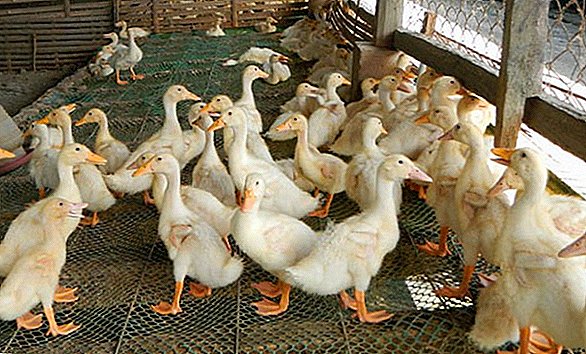 To feed the young in the first days of life is best protein foods, for example, boiled chicken yolk, dairy products - kefir, yogurt, low-fat cottage cheese, milk, etc.
To feed the young in the first days of life is best protein foods, for example, boiled chicken yolk, dairy products - kefir, yogurt, low-fat cottage cheese, milk, etc.
Gradually add to the mixture chopped greens, which we give to adults. From the tenth day we introduce boiled and pureed root vegetables into the diet.
Important! During the first days of life, ducklings should be carefully observed: if they do not eat on their own, sometimes they have to be pipetted with a very weak solution of potassium permanganate followed by slipping mashed boiled eggs under their beak. Such a reception often helps to stimulate the process of eating.
You can feed ducklings with high-quality compound feed, cereals, crushed grain. It is only important that the food be varied and balanced.  The number of meals in the initial stages is up to five times a day, while the young should always be able to drink clean water.
The number of meals in the initial stages is up to five times a day, while the young should always be able to drink clean water.
Finally, an important prerequisite for the normal development of young stock is room space: for four babies in the house, ideally no more than two adult ducks should be located.
If all these rules are strictly followed, your family will always be provided not only with excellent meat and nutritious eggs, but also a fairly good income.


